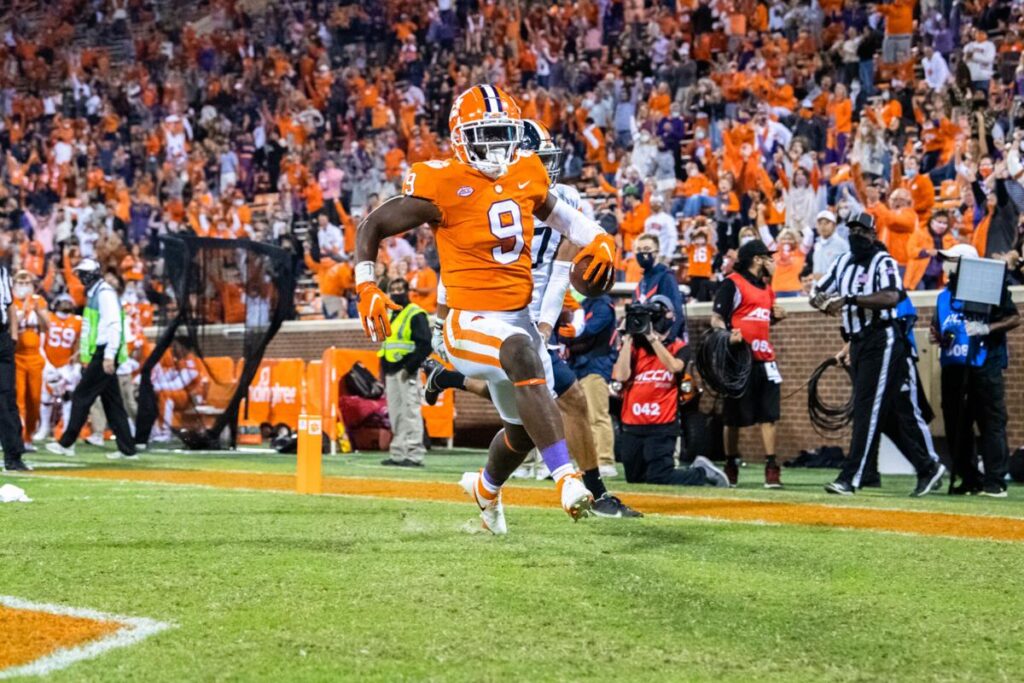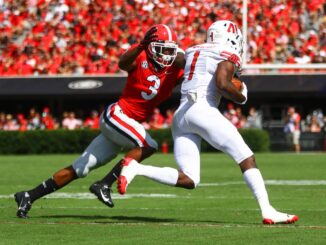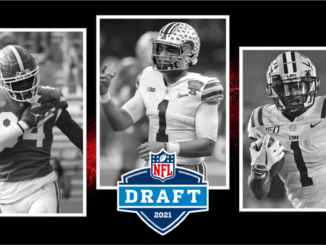This year’s running back class might lack a single elite prospect, but it makes up for it with tremendous depth. The consensus top three backs each offer different skillsets and could go off the board in any order depending on team needs. There are likely to be a number of intriguing options in the later rounds too, and teams can pick up potential starters well into Day 3.
1. Travis Etienne – Clemson

Pros: Etienne has elite speed and is a home-run threat every time he touches the football. His record at Clemson speaks for itself and he broke the 42-year old ACC record for career rushing yards with 4,956 and has 78 career touchdowns to his name. He averaged an impressive 7.2 yards per carry throughout his career, 62 per cent of which came after contact. His contact balance is elite and he averaged 0.32 forced missed tackles per attempt. He developed into a legitimate receiving weapon out of the backfield this season and is comfortable being flexed out wide and running a variety of routes.
Cons: Etienne often tries to do too much and overcomplicates things. He has a frustrating tendency to bounce runs outside when easy yardage is available up the middle and he needs to be more disciplined in taking what the defense gives him. The other big concern will be whether or not he can handle a higher workload as he hasn’t had a single game with 20+ carries since 2018. Etienne still has some way to go in order to be effective in pass protection. It is also worth noting that whilst his rushing numbers in 2020 were still impressive, they dropped off substantially from 2019.
Projection: 2nd round
2. Javonte Williams – UNC

Pros: Williams was the most elusive player in college football last season. He set the collegiate record for forced missed tackles per attempt at 0.48 and averaged 4.59 yards after contact per attempt. It is rare to find a running back who can match Williams’ contact balance and he does a great job of working through contact and keeping his legs moving. Whilst he doesn’t have elite long speed he has short area quickness and is a consistent big play threat, with 23.2 per cent of his carries going for 10+ yards. He pairs good vision with a patient running style and knows when to bounce out and when to take the easy yardage. Ball security is another major plus, with just three fumbles on 365 career carries.
Cons: There will be questions about whether or not Williams can hold up to the workload of a lead back. He shared the backfield at UNC with Michael Carter and averaged just 13.4 carries per game over the last two seasons. That being said, bell-cow backs are becoming less important as the NFL adopts a backfield-by-committee approach. Williams is not going to offer a tonne in the passing game immediately and he logged three drops on 27 catchable passes this season. He’s got sufficient long speed but isn’t going to outrun defensive backs in space.
Projection: 2nd round
3. Najee Harris – Alabama

Pros: Harris has prototypical power back size and he runs with real toughness. His 71 forced missed tackles rank second to only Javonte Williams amongst draft-eligible backs and he will have no issue translating this aspect of his game to the NFL. He is also an incredibly smooth and fluid mover for his size and showcases great change of direction ability. Harris has also proven himself to be one of the best receiving backs in the 2021 class. He has soft hands and has registered just three drops on 83 catchable passes throughout his career. Whilst he might not have the upside of an Etienne or Williams, Harris is a high-floor prospect.
Cons: Harris’ biggest weakness is his lack of speed. He lacks any sort of breakaway quickness and this will only be more of an issue in the NFL. Only 8.4 per cent of his career carries have gone for 15+ yards. For context, Etienne and Williams were at 12.4 and 11.5 per cent respectively. Despite his size he is a surprisingly poor pass protector and was a liability on occasion for Alabama. It is also worth noting that he benefitted from running behind the best offensive line in football and that played a huge part in his production. At 23, he is on the older end of the spectrum for a running back prospect.
Projection: 2nd round
4. Michael Carter – UNC

Pros: Carter was a two-year starter for UNC and registered back-to-back 1,000 yard seasons. His 2020 tape was particularly impressive and he averaged 7.9 yards per carry. He is a twitchy back with excellent change of direction ability. He offers ideal long speed in addition to his short area quickness and this helped him to lead the nation in runs of 15+ yards in 2020. Carter plays far bigger than his size would suggest and is a tough runner who will consistently fight for extra yardage. UNC used him as their primary receiving back and he showed good hands and the ability to run a variety of routes from the backfield.
Cons: Whilst Carter is a tough and willing runner, teams will have concerns about his ability to hold up as a lead back in the NFL. At just 5’8″ and 199 lbs he is small and won’t be a big play threat between the tackles. He also shared the UNC backfield with Javonte Williams and as such has never had to shoulder an RB1 workload. Although Carter is a weapon as a receiver, he can struggle to hold up in pass protection as a result of his diminutive frame.
Projection: 3rd round
5. Kenneth Gainwell – Memphis

Pros: Gainwell is arguably the best receiving back in the 2021 class. He featured as a key part of Memphis’ passing game and is capable of flexing out wide and running routes as a receiver. He does a great job of tracking the ball downfield and has proven himself capable of winning at all three levels. Gainwell has the tools to switch to a full-time slot receiver role in the NFL and would benefit from a creative offensive scheme. As a runner he is incredibly elusive, with great vision and lateral agility. His contact balance is underrated and he showcases excellent second effort to create after contact. In 2019 he was the only player in the FBS to log 1,000+ rushing yards and 500+ receiving yards.
Cons: At 5’11” and 191 lbs, Gainwell lacks prototypical running back size. Unsurprisingly he is a liability in pass protection and lacks the strength you want from an NFL back. Whilst his short area quickness is excellent, he lacks elite long speed that you might expect from a smaller back and that is a tough combination to get behind. Sample size will be another issue and Gainwell has just one season as a starter to his name. There is a role for Gainwell in the NFL, but it is unlikely to be as a lead back.
Projection: 3rd round
6. Khalil Herbert – Virginia Tech

Pros: Herbert has some of the best vision in the 2021 class. He reads the game well, with a good feel for cutback lanes. He demonstrates a very patient running style and allows blocks to develop before hitting the hole. At just 5’9″ and 212 lbs he offers a naturally low centre of gravity and this helps a tonne when it comes to contact balance. He rarely goes down on first contact and averaged an absurd 4.74 yards after contact in 2020, which led the FBS. Herbert also offers excellent short area quickness and changes direction without sacrificing much in the way of speed. 22 per cent of his carries last season went for 10+ yards, which was the fourth highest rate in college football.
Cons: Herbert’s biggest weakness is what he offers in the passing game. He has just 35 career receptions and never had more than 10 in a single season. His route tree is pretty limited and consists mainly of flats and swings. He also struggled at times in pass protection and this will limit his ability to be a true three-down back in the NFL. Herbert is one of the oldest running back prospects in this year’s draft, turning 23 before the start of his rookie season. Teams will also want to do their due diligence on his decision to leave Kansas midway through the 2019 season, the reasons for which remain unclear.
Projection: 3rd round
7. Chris Evans – Michigan

Pros: Evans is a smooth runner, with great change of direction ability. He has the size to run through defenders but he is capable of making them miss in space and is a good one-cut runner. He has been consistently excellent at forcing missed tackles, with 82 on 320 career carries. Where Evans adds real value is as a pass catcher. Michigan often used him in the slot and even out wide and he spent 23.2 per cent of his career snaps as a receiver. He has soft hands and is comfortable making catches outside his frame. Evans has just two drops on 51 career catchable passes. Despite being a redshirt senior, there isn’t much tread on his tyres, with just 369 career touches.
Cons: The biggest problem with Evans is recent experience. He was on academic suspension for the entire 2019 season and had just 16 carries in 2020. As a result, it is over two years since we saw him as a regular feature of Michigan’s backfield. He has had just 15+ carries once since the 2017 season and it is difficult to project how he would translate to a bigger role at the next level. He is also one of the oldest running back prospects, turning 24 in his rookie season. The tools are all there for Evans to be a quality NFL back, but there is substantial risk involved that might scare some teams off.
Projection: 4th round
8. Trey Sermon – Ohio State

Pros: Sermon offers some of the best contact balance in the 2021 class. Defenders struggle to stop him one-on-one and he averaged over four yards after contact this season. He plays with a physical style and does a great job of keeping his legs churning through contact. Whilst he lacks ideal speed, he has good short area burst and this helped him take 23 per cent of his carries for 10+ yards. Whilst he hasn’t always shown it, the high end of his play is intriguing. In 2020 he broke the Ohio State single game rushing yard record with 331 yards on 29 carries against Northwestern.
Cons: Sermon doesn’t have the top end speed that you want from a running back prospect. He will get chased down in the open field in college and that will only be more of a problem in the NFL. He has a noticeably upright running style and needs to play with better pad level if his physicality is going to translate to the NFL. Sermon was rarely using in the passing game by Oklahoma or Ohio State and offers little more than a basic checkdown option at this point.
Projection: 4th round
9. Demetric Felton – UCLA

Pros: Felton ranks alongside Kenneth Gainwell as the best receiving back in this class. He was initially recruited as a wide receiver and showed at the Senior Bowl that he is capable of running a diverse route tree and beating defensive backs in man coverage. It would not be a surprise if his future is as a slot receiver. As a runner he is one of the most shifty players in space and offers great burst. He won’t break a tonne of tackles but he excellent at forcing misses in the open field and showcases excellent change of direction ability. Felton won’t be everyone’s preference, but he has real potential in the right scheme.
Cons: Whilst Felton’s receiving ability is not in doubt, there will be concerns about whether or not he can stick at running back. At just 5’9″ and 190 lbs he is incredibly small for the position and struggles to run between the tackles. He rarely breaks tackles and is a liability in pass protection too. Felton also lacks the home-run speed that you might expect from a smaller back and he is more quick than fast. Whilst he could likely play a role out of the backfield in the NFL, this would need to be in a creative offense that didn’t treat him as a lead back.
Projection: 4th round
10. Kylin Hill – Mississippi State

Pros: Hill is an explosive player, with the short area quickness you want from a starting back. He demonstrates excellent vision in the open field and the ability to consistently make defenders miss, with an average of 0.25 forced missed tackles per attempt. Although he played just three games in 2020, he showed he could perform as a receiver out of the backfield and he is comfortable making catches outside his frame. He finished the year with 23 catches for 234 yards, with just one drop. Ball security is another big plus point and Hill has fumbled just once on 453 career carries.
Cons: Hill can be a little impatient as a runner and doesn’t always wait for his blocks to develop. He is also the type of runner who tries to do too much and finds himself running laterally far too often. He would benefit from playing with a more measured and disciplined approach. Whilst his acceleration is excellent, Hill doesn’t have ideal long speed. This shows in his 8.6 per cent explosive run rate. He needs to do a better job of running behind his pads and his upright style could cause him problems in the NFL.
Projection: 5th round


